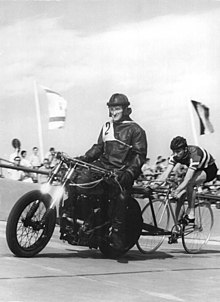Pacemaker (cycling)


In cycling, the pacemaker is the part of the team that drives in front of them in standing or derny races .
history
Multi-seat bicycles, so-called trip, quadruple, quintup and sextuplets, were originally used as a “pacemaker” to make cycling races faster from the 1880s onwards. Motorized pacemaker machines were first used in the 1899 World Track Cycling Championships in Montreal. At the end of the 1890s, electric tandems were even used, but also motor tandems. Early pacemaker machines were mostly in-house designs that were created in cooperation between companies, racing drivers and pacemakers.
Legally speaking, pacemakers are employees of their respective drivers, but they are honored at championships so that a Dutch pacemaker can become German champions. In 1973, on the occasion of the UCI Track World Championships 1973 in San Sebastián , the Union Cycliste Internationale (UCI) (World Cycling Association) wanted to change this and stipulate that pacemakers and stayers must have the same nationality. The Dutch pacemaker Bruno Walrave was thus prevented from defending the world championship he had won in 1971 and 1972 together with the Nuremberg amateur star Horst Gnas .
Walrave and his Dutch colleague Norbert Koch saw their right to freely exercise their activities within the European Economic Community (EEC) as a result of this regulation . The decision of the European Court of Justice (ECJ) of December 12, 1974 in Case 36-74 in favor of Walrave and Koch is, among other things, the basis of the so-called “ Bosman decision ” from 1995.
technology
One of the first pacemaker machines was the De-Dion-Bouton motor tricycle , which was "tested" as a leading machine around 1900. Attempts with the Bête de Vitesse are documented for 1905, from 1907 V2 engines a. a. by Laurin & Klement and in 1909 even the W3 by Alessandro Anzani . In 1938, a two-stroke engine was used in a pacemaker machine for the first time . The Roger Derny in Vichy developed Derny is up to today in Six Days and Keirin used.
Pacemaker machines are specially converted motorcycles based on series machines. The special features are the saddle construction, the footrests, the handlebars and the castor frame. The role serves to guarantee every driver (standing) the same distance to the pacemaker (and thus the same slipstream ) as well as a necessary level of safety. The bench is removed and replaced with a triangular saddle. This is inclined and attached higher than the normal bench. This and the special handlebars as well as the special footrests enable the pacemaker to take a standing position on the machine. However, the term “stayer” has nothing to do with it, but is based on the English term stayer , which comes from equestrian sport, for a horse with stamina.
The upright drives freely behind the pacemaker. He is in no way affiliated with her. He only moves by his own leg strength. The freely rotating roller is mounted on the rear frame of the pacemaker machine and guarantees the necessary distance between the stand and the motorcycle; it serves the safety of the upright by preventing the person standing up from running into the rear wheel of the pacemaker. The greater the distance between the roller, the slower the speed, as this pushes the stalker backwards out of the slipstream of the pacemaker. The protective role became mandatory after the racetrack disaster in Berlin on the “Botanischer Garten” cycle track on July 18, 1909, in which nine spectators were fatally injured and over 40 people were seriously injured.
In the early days of the standing races, pacemakers tried to increase the slipstream for the driver by attaching them to the motorcycles and creating a gap (see photo by Bruno Demke, below). It's forbidden these days. The pacemakers wear uniform leather clothing during races, which is usually black, which is why they are called Cholesack in Switzerland .
The standing race is one of the most difficult competitive sports. In doing so, speeds of sometimes over 100 km / h are achieved and maintained over longer sections. Standing races go over distances of up to 100 km. The communication between the stayer and the pacemaker takes place through internationally defined call signs. The experience and tactical skill of the pacemaker can be decisive for the race.
Oscar Hedstrom pacemaker machine , 1900
Standing Bruno Demke with pacemaker (ca.1905)
Pacemaker machine with Dieter Durst
Pacemaker on the Bielefeld Velodrome
Pacemaker motorcycles in the Cologne bicycle stadium
See also
literature
- Toni Theilmeier: The wild, daring hunt. The rise of professional standing sport in Germany. The early years up to 1910 (= series of publications on bicycle history. Volume 6). Kutschera, Leipzig 2009, ISBN 978-3-931965-23-5 .
Individual evidence
- ↑ Decision of the European Court of Justice (ECJ) of December 12, 1974 in the case 36-74
- ↑ Toni Theilmeier: The wild, daring hunt. P. 189.
- ↑ Toni Theilmeier: The wild, daring hunt. Pp. 198, 199.
- ↑ Stayer.de
- ↑ Peter Schnyder (Ed.): Oerlikon race track. 100 years of fascination with cycling. AS-Verlag, Zurich 2012, ISBN 978-3-909111-95-4 , p. 38.






